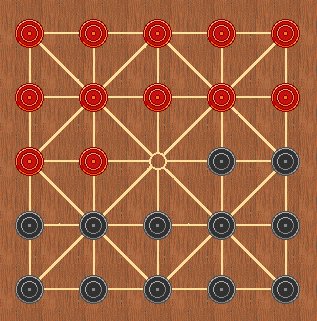

In his book Draughts in relation to chess and alquerque (2005) Arie van der Stoep contends that Alquerque de doze was in medieval times played by the following rules. Counters can move and capture, by the short leap, forwards and sideways. Capture is not compulsory. Counters are promoted to Sultans at the last rank. The Sultan (King) moves and captures in all directions. Counters are obliged to follow the pattern on the board. Goal is to capture all the opponent’s counters.
There existed two variants of Medieval Alquerque. In one version the Sultan can only move one square (short Sultan), and captures by the short leap. This was foremostly played in countries within the Roman sphere of influence. In the other variant the Sultan moves any number of squares, and captures like the King in international draughts, landing anywhere behind the captured piece. This was foremostly played in countries within the Arabic sphere of influence. In Sultan endgames, a majority of at least two Sultans is necessary for a win.
The above rules are much different from the rules of Alquerque as they have hitherto been understood. The most interesting rule is that capture is uncompelled. What speaks in this game’s favour is that it’s more interesting than the traditional rendition of Alquerque de doze, which, allegedly, was played without promotion, and where capture was compulsory.
A counter moves to an empty adjacent point. If an adjacent point is occupied by an enemy counter and the point directly behind is vacant, then one can jump over it and capture it, as in checkers. Several pieces may be captured like this in a single turn.
References
Arie van der Stoep, Draughts in relation to chess and alquerque. (2005)
See also ‘The history of checkers/draughts’ (here)
☛ You can download my free Medieval Alquerque program here (updated 2020-10-16), but you must own the software Zillions of Games to be able to run it.
© M. Winther 2006